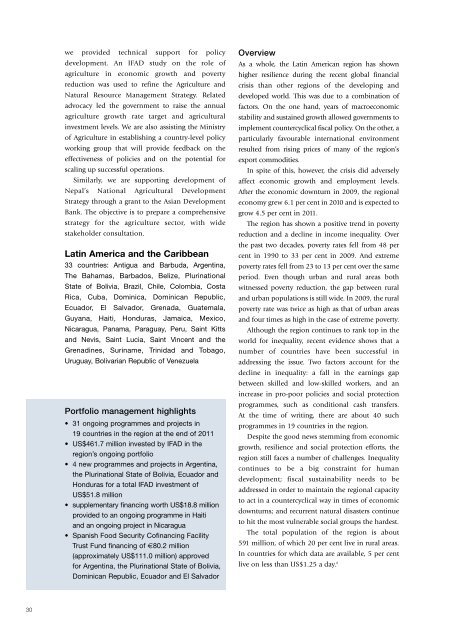ANNUAL REPORT 2011 - IFAD
ANNUAL REPORT 2011 - IFAD
ANNUAL REPORT 2011 - IFAD
Create successful ePaper yourself
Turn your PDF publications into a flip-book with our unique Google optimized e-Paper software.
30<br />
we provided technical support for policy<br />
development. An <strong>IFAD</strong> study on the role of<br />
agriculture in economic growth and poverty<br />
reduction was used to refine the Agriculture and<br />
Natural Resource Management Strategy. Related<br />
advocacy led the government to raise the annual<br />
agriculture growth rate target and agricultural<br />
investment levels. We are also assisting the Ministry<br />
of Agriculture in establishing a country-level policy<br />
working group that will provide feedback on the<br />
effectiveness of policies and on the potential for<br />
scaling up successful operations.<br />
Similarly, we are supporting development of<br />
Nepal’s National Agricultural Development<br />
Strategy through a grant to the Asian Development<br />
Bank. The objective is to prepare a comprehensive<br />
strategy for the agriculture sector, with wide<br />
stakeholder consultation.<br />
Latin America and the Caribbean<br />
33 countries: Antigua and Barbuda, Argentina,<br />
The Bahamas, Barbados, Belize, Plurinational<br />
State of Bolivia, Brazil, Chile, Colombia, Costa<br />
Rica, Cuba, Dominica, Dominican Republic,<br />
Ecuador, El Salvador, Grenada, Guatemala,<br />
Guyana, Haiti, Honduras, Jamaica, Mexico,<br />
Nicaragua, Panama, Paraguay, Peru, Saint Kitts<br />
and Nevis, Saint Lucia, Saint Vincent and the<br />
Grenadines, Suriname, Trinidad and Tobago,<br />
Uruguay, Bolivarian Republic of Venezuela<br />
Portfolio management highlights<br />
• 31 ongoing programmes and projects in<br />
19 countries in the region at the end of <strong>2011</strong><br />
• US$461.7 million invested by <strong>IFAD</strong> in the<br />
region’s ongoing portfolio<br />
• 4 new programmes and projects in Argentina,<br />
the Plurinational State of Bolivia, Ecuador and<br />
Honduras for a total <strong>IFAD</strong> investment of<br />
US$51.8 million<br />
• supplementary financing worth US$18.8 million<br />
provided to an ongoing programme in Haiti<br />
and an ongoing project in Nicaragua<br />
• Spanish Food Security Cofinancing Facility<br />
Trust Fund financing of €80.2 million<br />
(approximately US$111.0 million) approved<br />
for Argentina, the Plurinational State of Bolivia,<br />
Dominican Republic, Ecuador and El Salvador<br />
Overview<br />
As a whole, the Latin American region has shown<br />
higher resilience during the recent global financial<br />
crisis than other regions of the developing and<br />
developed world. This was due to a combination of<br />
factors. On the one hand, years of macroeconomic<br />
stability and sustained growth allowed governments to<br />
implement countercyclical fiscal policy. On the other, a<br />
particularly favourable international environment<br />
resulted from rising prices of many of the region’s<br />
export commodities.<br />
In spite of this, however, the crisis did adversely<br />
affect economic growth and employment levels.<br />
After the economic downturn in 2009, the regional<br />
economy grew 6.1 per cent in 2010 and is expected to<br />
grow 4.5 per cent in <strong>2011</strong>.<br />
The region has shown a positive trend in poverty<br />
reduction and a decline in income inequality. Over<br />
the past two decades, poverty rates fell from 48 per<br />
cent in 1990 to 33 per cent in 2009. And extreme<br />
poverty rates fell from 23 to 13 per cent over the same<br />
period. Even though urban and rural areas both<br />
witnessed poverty reduction, the gap between rural<br />
and urban populations is still wide. In 2009, the rural<br />
poverty rate was twice as high as that of urban areas<br />
and four times as high in the case of extreme poverty.<br />
Although the region continues to rank top in the<br />
world for inequality, recent evidence shows that a<br />
number of countries have been successful in<br />
addressing the issue. Two factors account for the<br />
decline in inequality: a fall in the earnings gap<br />
between skilled and low-skilled workers, and an<br />
increase in pro-poor policies and social protection<br />
programmes, such as conditional cash transfers.<br />
At the time of writing, there are about 40 such<br />
programmes in 19 countries in the region.<br />
Despite the good news stemming from economic<br />
growth, resilience and social protection efforts, the<br />
region still faces a number of challenges. Inequality<br />
continues to be a big constraint for human<br />
development; fiscal sustainability needs to be<br />
addressed in order to maintain the regional capacity<br />
to act in a countercyclical way in times of economic<br />
downturns; and recurrent natural disasters continue<br />
to hit the most vulnerable social groups the hardest.<br />
The total population of the region is about<br />
591 million, of which 20 per cent live in rural areas.<br />
In countries for which data are available, 5 per cent<br />
live on less than US$1.25 a day. 6

















